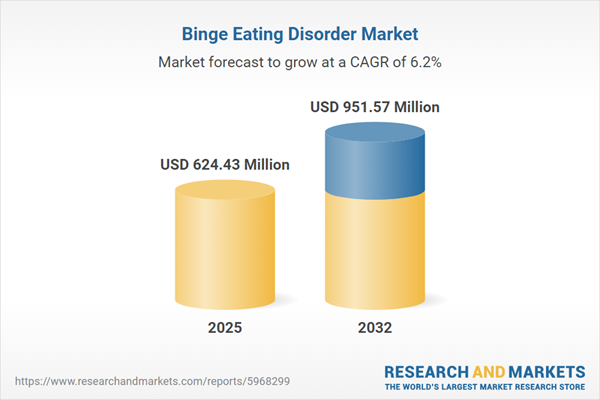Speak directly to the analyst to clarify any post sales queries you may have.
The Binge Eating Disorder Market is evolving rapidly, influenced by changing patient needs, technological advancements in treatment, and increasingly sophisticated regulatory requirements. Senior leaders in healthcare and life sciences must navigate these trends to drive sustainable growth and optimize care delivery.
Market Snapshot
The Binge Eating Disorder Market grew from USD 587.85 million in 2024 to USD 624.43 million in 2025. It is expected to continue growing at a CAGR of 6.20%, reaching USD 951.57 million by 2032.
Scope & Segmentation
- Treatment Type – Digital therapeutics, including mobile app and web-based tools; pharmacotherapy, covering antidepressants, antiepileptics, and stimulants; psychotherapy such as cognitive behavioral therapy, dialectical behavior therapy, and interpersonal psychotherapy.
- Distribution Channel – Home healthcare services; hospitals and clinics; online platforms; specialty treatment centers.
- End User – Adolescents; adults; elderly populations.
- Treatment Setting – Inpatient and outpatient pathways.
- Regional Coverage – Americas (including North America: United States, Canada, Mexico; and Latin America: Brazil, Argentina, Chile, Colombia, Peru), Europe, Middle East & Africa (with distinct profiles for United Kingdom, Germany, France, Russia, Italy, Spain, Netherlands, Sweden, Poland, Switzerland, United Arab Emirates, Saudi Arabia, Qatar, Turkey, Israel, South Africa, Nigeria, Egypt, Kenya), and Asia-Pacific (China, India, Japan, Australia, South Korea, Indonesia, Thailand, Malaysia, Singapore, Taiwan).
- Company Profiles – Key organizations include Takeda Pharmaceutical Company Limited, Teva Pharmaceutical Industries Limited, AbbVie Inc., Amneal Pharmaceuticals, Sandoz International GmbH, Sun Pharmaceutical Industries Limited, Lupin Limited, Viatris Inc., Dr. Reddy's Laboratories Limited, and Apotex Inc.
Key Takeaways
- Clinical innovation is broadening patient access, with digital and in-person therapies forming a more unified care continuum. Mobile apps and web-based interventions are increasingly integrated into traditional care frameworks.
- Market participants are optimizing resource deployment by tracking real-world patient outcomes and refining care models for holistic and personalized treatment.
- Segmented strategies are essential, as different age groups and care settings show varied therapeutic needs and preferences, requiring tailored intervention approaches.
- Strategic partnerships between pharmaceutical companies, technology vendors, and providers are reshaping market competition and accelerating the roll-out of advanced solutions.
- Leadership is marked by the ability to address both emotional and physical aspects of patient care, informed by emerging behavioral health data analytics.
- Providers adjust to evolving reimbursement models and policy changes by prioritizing value-based contracts and outcome-driven service delivery.
Tariff Impact: Navigating Regulatory and Supply Chain Changes
Recent United States tariffs have increased production costs for key therapeutics and digital devices through higher import duties on both active pharmaceutical ingredients and hardware. In response, industry leaders are diversifying sourcing strategies, investing in domestic manufacturing, and revisiting pricing models to preserve access while managing expenses. Some treatment providers are implementing tiered offerings and optimizing inventory management to maintain service quality within the shifting economic landscape.
Methodology & Data Sources
This report is based on a rigorous blended methodology, combining primary interviews with clinicians, product developers, and key opinion leaders, along with secondary analysis of published clinical studies and regulatory filings. Quantitative modeling and qualitative stakeholder insights ensure comprehensive, actionable coverage.
Binge Eating Disorder Market: Why This Report Matters
- Gain clarity on regional and segment-specific drivers impacting the adoption of digital and therapeutic innovations.
- Support investment, portfolio, and partnership decisions with validated data and in-depth analysis of the competitive and regulatory environment.
- Identify actionable opportunities for value-based care transformation and technology-driven patient engagement across global markets.
Conclusion
The binge eating disorder landscape is shifting as care models, reimbursement strategies, and technologies evolve in response to changing needs and policy environments. Senior decision-makers can use these insights to align growth initiatives and optimize operational effectiveness while supporting improved outcomes for diverse patient segments.
Additional Product Information:
- Purchase of this report includes 1 year online access with quarterly updates.
- This report can be updated on request. Please contact our Customer Experience team using the Ask a Question widget on our website.
Table of Contents
3. Executive Summary
4. Market Overview
7. Cumulative Impact of Artificial Intelligence 2025
Companies Mentioned
The companies profiled in this Binge Eating Disorder market report include:- Takeda Pharmaceutical Company Limited
- Teva Pharmaceutical Industries Limited
- AbbVie Inc.
- Amneal Pharmaceuticals, Inc.
- Sandoz International GmbH
- Sun Pharmaceutical Industries Limited
- Lupin Limited
- Viatris Inc.
- Dr. Reddy's Laboratories Limited
- Apotex Inc.
Table Information
| Report Attribute | Details |
|---|---|
| No. of Pages | 182 |
| Published | October 2025 |
| Forecast Period | 2025 - 2032 |
| Estimated Market Value ( USD | $ 624.43 Million |
| Forecasted Market Value ( USD | $ 951.57 Million |
| Compound Annual Growth Rate | 6.2% |
| Regions Covered | Global |
| No. of Companies Mentioned | 11 |









